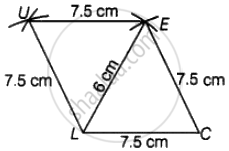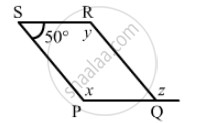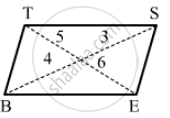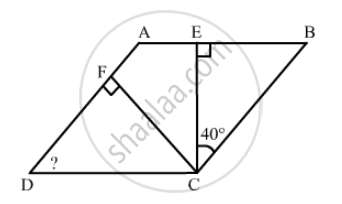Advertisements
Advertisements
प्रश्न
Construct a rhombus CLUE in which CL = 7.5 cm and LE = 6 cm.
उत्तर
We know that, all sides of a rhombus are equal and opposite sides are parallel to each other.

Steps of construction:
Step I: Draw a line segment CL = 7.5 cm.
Step II: With C as a centre, draw an arc CE = 7.5 cm.
Step III: With L as a centre, draw an another arc LU = 7.5 cm.
Step IV: Now, with centre L, draw an arc LE = 6 cm, that is cut-off previous arc CE.
Step V: With E as a centre, draw an arc UE = 7.5 cm, that is cut-off previous arc LU.
Step VI: Now join UL, CE and EU.
Hence, CLUE is a required rhombus.
APPEARS IN
संबंधित प्रश्न
The following figure is parallelogram. Find the degree values of the unknown x, y, z.

Can the following figure be parallelogram. Justify your answer.

In a parallelogram ABCD, ∠D = 135°, determine the measure of ∠A and ∠B.
Find the angles marked with a question mark shown in Fig. 17.27

In the following Figure ABCD is a arallelogram, CE bisects ∠C and AF bisects ∠A. In each of the following, if the statement is true, give a reason for the same:

(i) ∠A = ∠C
(ii) \[\angle FAB = \frac{1}{2}\angle A\]
(iii) \[\angle DCE = \frac{1}{2}\angle C\]
(iv) \[\angle CEB = \angle FAB\]
(v) CE || AF
Fill in the blank, in the following, so as to make the statement true:
A rhombus is a parallelogram in which ......
Draw a rhombus ABCD, if AB = 6 cm and AC = 5 cm.
ABCD is a rhombus whose diagonals intersect at O. If AB = 10 cm, diagonal BD = 16 cm, find the length of diagonal AC.
State with reason whether the following statement is ‘true’ or ‘false’.
Every rhombus is a rectangle.
In rhombus ABCD;
(i) if ∠A = 74° ; find ∠B and ∠C.
(ii) if AD = 7.5 cm ; find BC and CD.
